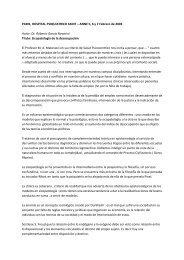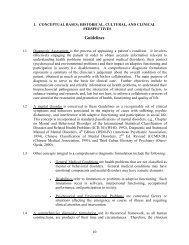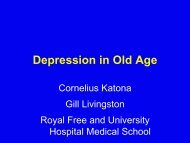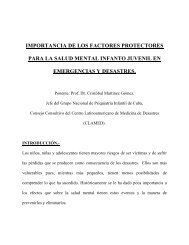Volume 3, Number 1 - February 2004 - World Psychiatric Association
Volume 3, Number 1 - February 2004 - World Psychiatric Association
Volume 3, Number 1 - February 2004 - World Psychiatric Association
Create successful ePaper yourself
Turn your PDF publications into a flip-book with our unique Google optimized e-Paper software.
ization of services, professional diversification) are notproportionate to the system’s quality (again, as before,there is of course a minimum critical mass of resourcesbelow which quality is simply impossible but, above this,quality is not granted by quantity). In other words, theequation R (resources) plus T (technologies) to be equal toQ (quality) requires one or more unknown variables.In the Patagonian province of Rio Negro, the psychiatrichospital has been replaced by home visits, vocationalrehabilitation, general hospital interventions, communitycare relying on an extended network of effective informalagents: the community is used as a resource.In the Brazilian city of Santos, the psychiatric hospitalis provided through a rich and articulated network of professionalswho enjoy a rather unique popularity amongthe population. They use as additional resources patientsthemselves! The “cost” becomes the resource.In the Indian Southern state of Tamil Nadu, the lack ofsolid public mental health service is replaced by a strongnetwork of non-governmental organizations of professionalsworking in close collaboration with family members:the informal provider becomes a formal partner.These three examples show informal resources andinformal technologies working as the unknown variablesresulting in quality.Lesson three. Differences in systems are much less thanone would expect. In spite of obvious huge differences inthe availability of technologies and resources, problemsand solutions (including bad solutions) remain rather similareven if nations, cultures and economies are diverse.Following the lessons learned, we can say thatunknown variables, quite similar among themselvesacross the world, can have a strong influence in increasingor decreasing the service quality in spite of the differencein resources and technologies.These unknown variables often result from the adoptionof paradigms which are relatively independent fromresources and technologies. These paradigms are coreassumptions, which affect the implementation of costeffectiveinterventions for mental disorders, makingresources useless or powerful. Core assumptions essentiallyreflect “values”.Let us examine four paradigms we have identified asfactors reducing or enhancing quality.PARADIGMSExclusion versus inclusionThe “exclusion approach” is not focused on patient’sexperience/need but rather on environment’s perceptionand need. This approach results in an overemphasis onsecurity issues, including an overestimate of dangerousness.We have noticed that systems where security preoccupationsprevail are generally of worse quality than thosewhere patients’ understanding is prevailing.When social organizations are extremely vertical (Stateis prevailing through a closed system of values), they tendto invest in control rather than in inclusion. Usually thesesocial organizations identify exclusion with large institutions.On the other hand, when social organizations arevery horizontal and the State is almost absent, they tendto organize exclusion in “diffuse institutions” where asylums’logic and rules remain in spite of the absence of visiblewalls: homelessness or abandonment to a wild privatesystem of care with no quality control.On the contrary, when a social organization startsaddressing a patient’s needs and looking at his/her pathologywithout denying the patient’s enjoyment of full citizenship,the necessity of exclusion decreases. Shifting theparadigm from exclusion to inclusion has obviously enormousconsequences in terms of investment in hospitalsand beds.Deinstitutionalization is therefore much more than simplede-hospitalization. It has to do with a radical assumptionof the meaning of the patient’s experience.It is interesting how the notion of bed is still prevailingin mental health service planning language. It is interestingto notice how in the world there are either too manybeds or, when there are too few, the only innovative ideais generally the one of creating new beds. Beds are not thesolution but rather the illusion of responding in a simple(simplistic) way to a complex demand, namely better care,effective rehabilitation, more enjoyment of full citizenship.Short-term care versus long-term careA radical shifting of the care paradigm is required.Health systems are conceived and organized to respond toacute cases (hospital model). After the acute phase isresolved, the patient enters a limbo of infrastructures,human resources, skills, responsibilities. At that point theprimary health care system appears as the deus ex machinathat in ancient Greek tragedies used to solve everything.The key question, instead, is “how the entire healthsystem can serve the needs of the patient when he/sherequires long-term care (keeping the enjoyment of his/herfull citizenship)?”. And this is not just for mental disorders,but for many chronic conditions requiring long-termcare (HIV/AIDS or tuberculosis, for example). Indeed,asylum temptation is there as the simplest and most devastatinganswer!In other words, we need a radical shifting from a modelcentred on space location of the provider (hospitals,ambulatory, clinic and so on) to one centred on a timedimension of the client. Acute and chronic are conditions,not places, and we can conceive managing acute aswell as chronic conditions at a community level more thanat the hospital level.Health systems tend to put resources and competenciesin the short-term care (namely, hospitals) and to ignore or4 <strong>World</strong> Psychiatry 3:1 - <strong>February</strong> <strong>2004</strong>
















